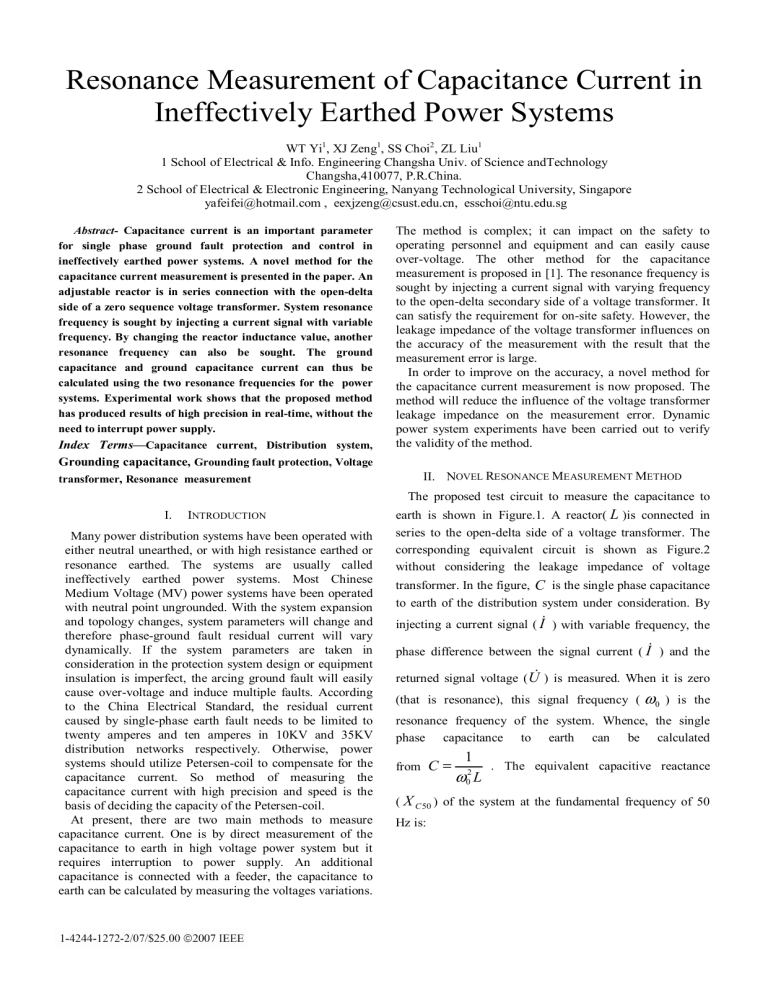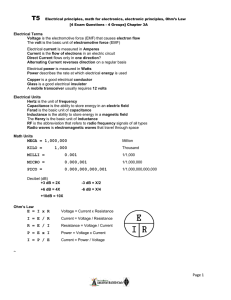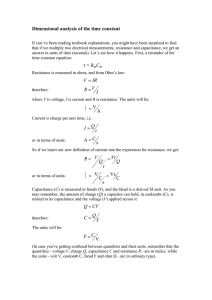Resonance measurement of capacitance current in ineffectively earthed power systems
advertisement

Resonance Measurement of Capacitance Current in Ineffectively Earthed Power Systems WT Yi1, XJ Zeng1, SS Choi2, ZL Liu1 1 School of Electrical & Info. Engineering Changsha Univ. of Science andTechnology Changsha,410077, P.R.China. 2 School of Electrical & Electronic Engineering, Nanyang Technological University, Singapore yafeifei@hotmail.com , eexjzeng@csust.edu.cn, esschoi@ntu.edu.sg Abstract- Capacitance current is an important parameter for single phase ground fault protection and control in ineffectively earthed power systems. A novel method for the capacitance current measurement is presented in the paper. An adjustable reactor is in series connection with the open-delta side of a zero sequence voltage transformer. System resonance frequency is sought by injecting a current signal with variable frequency. By changing the reactor inductance value, another resonance frequency can also be sought. The ground capacitance and ground capacitance current can thus be calculated using the two resonance frequencies for the power systems. Experimental work shows that the proposed method has produced results of high precision in real-time, without the need to interrupt power supply. Index Terms—Capacitance current, Distribution system, Grounding capacitance, Grounding fault protection, Voltage transformer, Resonance measurement The method is complex; it can impact on the safety to operating personnel and equipment and can easily cause over-voltage. The other method for the capacitance measurement is proposed in [1]. The resonance frequency is sought by injecting a current signal with varying frequency to the open-delta secondary side of a voltage transformer. It can satisfy the requirement for on-site safety. However, the leakage impedance of the voltage transformer influences on the accuracy of the measurement with the result that the measurement error is large. In order to improve on the accuracy, a novel method for the capacitance current measurement is now proposed. The method will reduce the influence of the voltage transformer leakage impedance on the measurement error. Dynamic power system experiments have been carried out to verify the validity of the method. II. NOVEL RESONANCE MEASUREMENT METHOD The proposed test circuit to measure the capacitance to I. INTRODUCTION Many power distribution systems have been operated with either neutral unearthed, or with high resistance earthed or resonance earthed. The systems are usually called ineffectively earthed power systems. Most Chinese Medium Voltage (MV) power systems have been operated with neutral point ungrounded. With the system expansion and topology changes, system parameters will change and therefore phase-ground fault residual current will vary dynamically. If the system parameters are taken in consideration in the protection system design or equipment insulation is imperfect, the arcing ground fault will easily cause over-voltage and induce multiple faults. According to the China Electrical Standard, the residual current caused by single-phase earth fault needs to be limited to twenty amperes and ten amperes in 10KV and 35KV distribution networks respectively. Otherwise, power systems should utilize Petersen-coil to compensate for the capacitance current. So method of measuring the capacitance current with high precision and speed is the basis of deciding the capacity of the Petersen-coil. At present, there are two main methods to measure capacitance current. One is by direct measurement of the capacitance to earth in high voltage power system but it requires interruption to power supply. An additional capacitance is connected with a feeder, the capacitance to earth can be calculated by measuring the voltages variations. earth is shown in Figure.1. A reactor( L )is connected in series to the open-delta side of a voltage transformer. The corresponding equivalent circuit is shown as Figure.2 without considering the leakage impedance of voltage transformer. In the figure, C is the single phase capacitance to earth of the distribution system under consideration. By injecting a current signal ( I ) with variable frequency, the phase difference between the signal current ( I ) and the returned signal voltage ( U ) is measured. When it is zero (that is resonance), this signal frequency ( ω0 ) is the resonance frequency of the system. Whence, the single phase capacitance to earth can be calculated from C = 1 ω 02 L . The equivalent capacitive reactance ( X C 50 ) of the system at the fundamental frequency of 50 Hz is: X C 50 = 1 ω 50C = 1 ω 50 1 ω 02 L = ω 02 L ω50 (1) Where ω50 is fundamental angular frequency, i.e.314 rad./sec in the 50-Hz system. L' U ′ R 1 C 3 I Figure.4 Simplified equivalent circuit of Figure.3 Select an additional reactor la , inject a current signal ( I ) with variable frequency, and seek the resonance frequency ( ω1 ) of the power system. Two equations can be derived: U L = jω 1 La ⋅ I Figure.1 Proposed capacitance current measurement method (2) 1 U ′ = − j ⋅ I ⋅ 3 + I ⋅ R + jω1 L ′ ⋅ I (3) ω 1C Where La is the equivalent reactance of l a referred to the primary side, U L is the voltage across the adjustable reactor ( l a). Changing the additional reactor to lb , repeat the measurement process and the resonance frequency Figure.2 Equivalent circuit for resonance measurement: with the voltage transformer leakage impedance ignored When including the leakage impedance of the voltage transformer, the equivalent circuit is shown as Figure.3. In the figure, L1 , R1 are the leakage inductance and the leakage resistance of the voltage transformer secondary coil respectively; Lm , Rm are the excitation inductance and the excitation resistance of the voltage transformer respectively; ω2 can also be obtained. The following equations can be obtained: U L = jω 2 Lb ⋅ I (4) 1 U ′ = − j ⋅ I ⋅ 3 + I ⋅ R + jω 2 L′ ⋅ I (5) ω 2C Where Lb is the equivalent inductance of lb referred to the primary side. The measured voltage ( U ) is composed of L2 , R2 are the leakage inductance and the leakage two parts, U = U L + U ′ . From the four equations (2)-(5), resistance one can derive the following two equations: of the voltage transformer primary coil respectively; and U ′ is the secondary voltage of voltage transformer referred to the primary side. The excitation current in the transformer is very small, so the excitation impedance can be neglected. The equivalent circuit can thus be simplified as Figure.4. Where R and L ′ are the leakage resistance and the inductance of the voltage transformer respectively. L1 U ′ I R1 L2 Lm Rm R2 1 C 3 Figure.3 Equivalent circuit for voltage transformer with the capacitance to earth (per phase) ω(1 La+L′) = 1 1 ω 1C 3 1 ω(2 Lb+L′) = 1 ω 2C 3 (6) (7) Therefore, the three-phase capacitance to earth of the distribution network can be calculated from 3C = 9 ⋅ ω12 − ω 22 ω12ω 22 ( Lb − La ) (8) The total capacitive current ( I c ) caused by a ground fault can be obtained: IC = 9 ⋅ TABLE I ω (ω12 − ω 22 )U Φ ω 12ω 22 ( Lb − La ) (9) Where ω and U Φ are the frequency and the phase voltage of the power system respectively. If the voltage transformation ratio of voltage transformer is k , (8) and (9) can be calculated as: ω −ω ω ω k (lb − l a ) (10) ω (ω − ω )U Φ ω12ω k 2 (lb − l a ) (11) 3C = 9 ⋅ IC = 9 ⋅ 2 1 2 1 2 2 2 2 1 2 2 2 2 2 2 III. EXPERIMENT Experiments have been carried out on a dynamic power system model in laboratory, and the experiment model is shown in Figure.5. Where C A , C B , C C are the single phase capacitance to earth of the network. The voltage transformation ratio of the zero sequence voltagetransformer is 100 3 ; The distribution system voltage is 10kV; lumped capacitances replace the ground capacitance. The adjustable reactor ( l ) is connected in series with the secondary side of the voltage transformer, and its inductance ranges from 1mH to 20mH . A variable frequency current signal of 0.5 ampere is injected into the secondary side. Figure.5 Circuit diagram of the experimental set-up Test results are shown in TABLE I. Where l1 , l2 are the selected reactors; f1 , f 2 are the resonance frequency corresponding to l1 , l2 respectively; 3C is the actual threephase capacitance to earth used in the test; 3C cal is the calculated three-phase capacitance to earth. Note that the influence of the voltage transformer leakage impedance has been considered, the largest error of the test measurements does not exceed 2.74%. MEARSUREMENT RESULTS l1 ( mH ) 5.4 5.4 5.4 5.4 5.4 l2 ( mH ) 14 14 14 14 1 f1 ( Hz ) 78 36.6 25.8 20.4 12 f 2 ( Hz ) 49.2 23.1 16.2 12 27.6 3C cal ( µ F) 0.219 0.996 2.039 4.012 9.726 3C ( µ F) 0.22 1 2 4 10 IV. CONCLUSIONE A novel method of capacitance current measurement for an ineffectively grounded power system is proposed in the paper. It uses an adjustable reactor which is in series connection with the open-delta side of a zero sequence voltage transformer. By injecting a signal with variable frequency, the power system resonance frequency can be sought. By changing the value of the reactor to another value, another resonance frequency is also obtained. Using the two resonance frequencies, the capacitance to earth can be calculated, where the leakage inductance of the voltage transformer will not influence the accuracy of the measurement. Experimental results show that the proposed method can achieve high measurement accuracy, and can be carried out without the need to interrupt power supply. REFERENCES [1] Zhang Xuhui. “Measurement device for grounding capacitance current”, (in Chinese) Patents in China, July.2001. [2] B Michael Aucion, Rober H Jones.High impedance fault detection implementation issues[J]. IEEE Trans on Power Delivery.1996.11(1):139-145 [3] IEEE recommended practice for grounding of industrial and commercial power systems, IEEE Std 142~1991. PP.17-80, 1991. [4] Joseph Sottile Jr., and Lawrence E. Holloway, “An overview of fault monitoring and diagnosis in mining equipment,” IEEE Transactions on Industry Applications, Vol.30, No.5, 1994, pp.1326-1332. [5] Zeng Xiangjun, Li K.K., Chan W.L., Yin Xianggen. “On-site safety evaluation for earth fault in mining power systems”. IEEE Transaction on Industry Applications Vol.39, No.6, Nov./Dec. 2003 1563-1569. [6] Novak T., and Kohler J. L., “Technological innovations in deep coal mine power systems,” IEEE transactions on industry applications, Vol.34, No.1, 1998, pp.196-204. [7] Zeng Xiangjun,Li K.K.,,Chan W.L.,Su Sheng "Grounding Faulted Feeder Detection with Fault Resistance Measurement in Mining Power Systems". Industry Applications Conference, Fortieth IAS Annual Meeting, 2005 Vol 1, 2-6 Oct. 2005 PP.657 – 661 [8] R.Willheim, and M.Waters, “Neutral grounding in high-voltage transmission,” New York: Elsevier, 1956. [9] John P. Nelson, and Pankaj K.Sen, “High-resistance grounding of lowvoltage systems: a standard for the petroleum and chemical industry,” IEEE transaction on industry application, Vol.35, No.4, 1999, pp. 941-948. [10] Zhao Zhengjun, Jiang Xinyu. “Research on capacitance current mearsurement with signal injection in distribution network”, (in Chinese) Guang Dong Electric Power, Vol.17, No.6, Dec.2004 [11] Lu Li, Sun Jiezhong. “ A new method to measure capacitance current in distribution network”, (in Chinese) Power System Technology, Vol.25, No.5, May.2001





